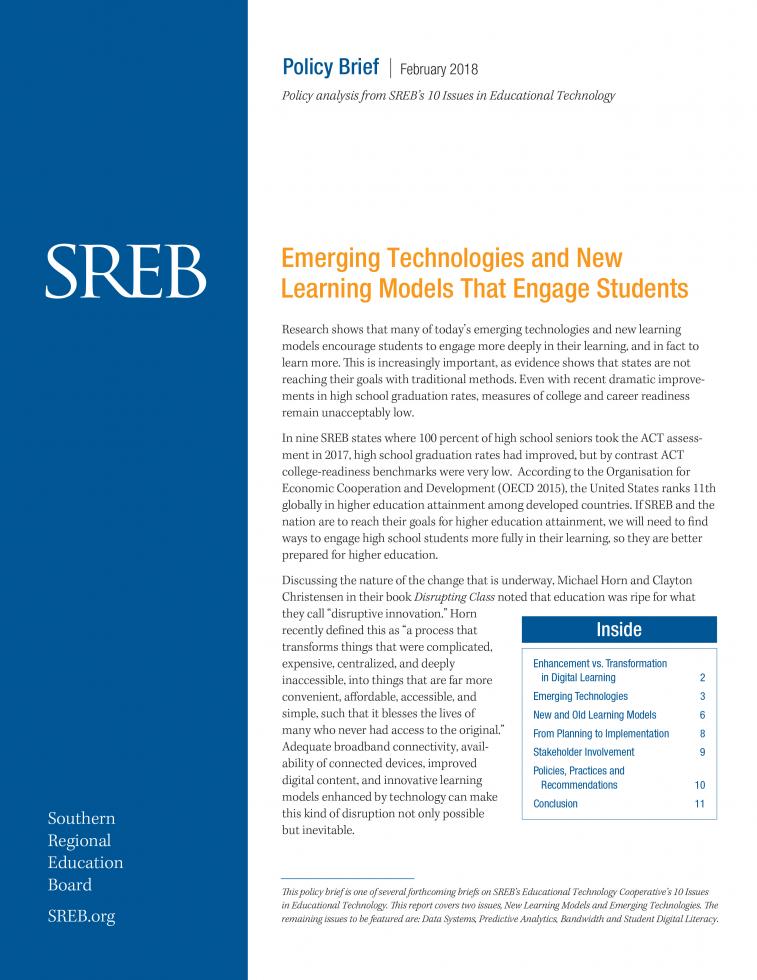Emerging Technologies
Emerging Technologies
Factor the relevance of emerging technologies into strategic decision-making. To maximize their benefits to students, foster professional development for educators.
The explosion in mobile technology and social networking has paralleled a rapid growth in educational technology applications and technology-mediated instruction. In 2017, the Gartner Hype Cycle for Education tracked over 50 emergent education-related technologies in various stages of development and implementation. These technologies represented various applications, promising practices and enhanced methods which attempt to meet evolving expectations for information and learning systems and for engaging students more deeply in their learning.
What is the issue and why is it important?
As educational technology continues to develop as an integral part of the overall ecosystem of education, education leaders are required — as an essential part of the comprehensive review of their institutions’ improvement strategy — to assess the degree to which emerging technologies can help them meet institutional goals, and therefore which they should consider adopting.
Emerging technologies can include stand-alone tools or applications (such as ones designed for specific classrooms), as well as technology systems (such as learning management systems, content repositories, or content management systems). Either type could support online or traditional classrooms, but emerging technologies take time to implement properly. They require training, support, and integration with existing technology systems and instructional practices.
What if SREB states do not make adequate progress on this issue?
As educational institutions strive to provide the best learning environment for their students, they continually seek up-to-date and engaging modes of instruction. This requires staying abreast of the most promising emerging educational technologies, while remaining appropriately skeptical until they prove themselves. Too many become yesterday’s fad after costing institutions money they could not aford to lose, while others turn out to be beyond their capacity to implement effectively.
Key factors in adopting emerging technologies include:
- total cost of ownership
- effectiveness in the classroom
- comparison with similar tools to determine the best
- integration into teaching processes
- privacy and security of devices and data generated by new tools
- scalability and comprehensive implementation plans for widespread adoption
- compatibility and interoperability of devices with existing systems
- support for the new apps, operating systems, and devices
- support of system upgrades and potential conflicts with browsers or other applications
- accessibility for students with disabilities
- alignment with student outcome goals
- training for teachers, administrators
- support staff for effective use and evaluation
As educators strive to provide the best learning environment for their students, they continually seek up-to-date and engaging modes of instruction.
Sometimes implementing emerging technologies means undertaking structural changes in instructional design or in the instructional environment, and educational leaders need to take extra precaution. At that point, leaders need to ensure that the technologies they decide to implement will likely add value and improve the instructional process over the long term and therefore will be worthy of an investment of time, staff resources and funding that goes beyond the costs of the technology.
The initial and recurring costs of updating or adding technology implementations strain state and institutional resources. But the costs of redesigning instruction go beyond the costs of the technology. Communication and collaboration among teachers and administrators, plus reliable processes for the evaluation of new technologies, will enable schools and institutions to realize the benefits of emerging technologies while accounting for costs.




